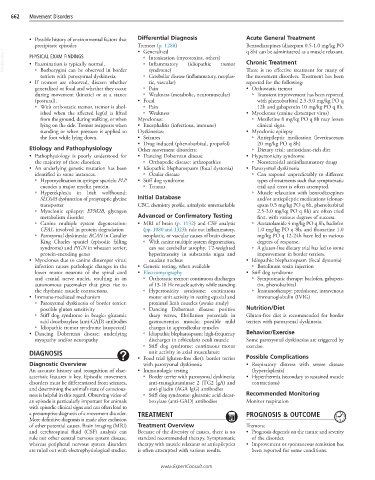Page 1313 - Cote clinical veterinary advisor dogs and cats 4th
P. 1313
662 Movement Disorders
• Possible history of environmental factors that Differential Diagnosis Acute General Treatment
precipitate episodes Tremors (p. 1288) Benzodiazepines (diazepam 0.5-1.0 mg/kg PO
VetBooks.ir PHYSICAL EXAM FINDINGS ○ Intoxication (mycotoxins, others) tremor Chronic Treatment
q 8h) can be administered as a muscle relaxant.
• Generalized
• Examination is typically normal.
(idiopathic
Inflammatory
○
syndrome)
○ Borborygmi can be observed in border
terriers with paroxysmal dyskinesia. ○ Cerebellar disease (inflammatory, neoplas- There is no effective treatment for many of
the movement disorders. Treatment has been
• If tremors are observed, discern whether tic, vascular) reported for the following:
generalized or focal and whether they occur ○ Pain • Orthostatic tremor
during movement (kinetic) or at a stance ○ Weakness (metabolic, neuromuscular) ○ Transient improvement has been reported
(postural). • Focal with phenobarbital 2.5-3.0 mg/kg PO q
○ With orthostatic tremor, tremor is abol- ○ Pain 12h and gabapentin 10 mg/kg PO q 8h.
ished when the affected leg(s) is lifted ○ Weakness • Myoclonus (canine distemper virus)
from the ground, during walking, or when Myoclonus: ○ Mexiletine 8 mg/kg PO q 8h may lessen
lying on the side. Tremor reappears when • Encephalitis (infectious, immune) clinical signs.
standing or when pressure is applied to Dyskinesias: • Myoclonic epilepsy
the foot while lying down. • Seizures ○ Antiepileptic medication (levetiracetam
• Drug induced (phenobarbital, propofol) 20 mg/kg PO q 8h)
Etiology and Pathophysiology Other movement disorders: ○ Dietary trial: antioxidant-rich diet
• Pathophysiology is poorly understood for • Dancing Doberman disease • Hypertonicity syndrome
the majority of these disorders. ○ Orthopedic disease: arthropathies ○ Nonsteroidal antiinflammatory drugs
• An underlying genetic mutation has been • Idiopathic blepharospasm (focal dystonia) • Paroxysmal dyskinesia
identified in some instances. ○ Ocular disease ○ Can respond unpredictably to different
○ Hypomyelination in springer spaniels: PLP • Stiff dog syndrome types of treatments such that symptomatic
encodes a major myelin protein. ○ Tetanus trial and error is often attempted.
○ Hyperekplexia in Irish wolfhound: ○ Muscle relaxation with benzodiazepines
SLC6A5 dysfunction of presynaptic glycine Initial Database and/or antiepileptic medications (clonaz-
transporter CBC, chemistry profile, urinalysis: unremarkable epam 0.5 mg/kg PO q 8h, phenobarbital
○ Myoclonic epilepsy: EPM2B, glycogen 2.5-3.0 mg/kg PO q 8h) are often tried
metabolism disorder Advanced or Confirmatory Testing first, with various degrees of success.
○ Canine multiple system degeneration: • MRI of brain (p. 1132) and CSF analysis ○ Acetazolamide 4 mg/kg PO q 8h, baclofen
CFA1, involved in protein degradation (pp. 1080 and 1323): rule out inflammatory, 1.0 mg/kg PO q 8h, and fluoxetine 1.0
○ Paroxysmal dyskinesia: BCAN in Cavalier neoplastic, or vascular causes of brain disease mg/kg PO q 12-24h have led to various
King Charles spaniel (episodic falling ○ With canine multiple system degeneration, degrees of response.
syndrome) and PIGN in wheaten terrier; can see cerebellar atrophy, T2-weighted ○ A gluten-free dietary trial has led to some
protein-encoding genes hyperintensity in substantia nigra and improvement in border terriers.
• Myoclonus due to canine distemper virus: caudate nucleus • Idiopathic blepharospasm (focal dystonia)
infection causes pathologic changes in the • Genetic testing, when available ○ Botulinum toxin injection
lower motor neurons of the spinal cord • Electromyography • Stiff dog syndrome
and cranial nerve nuclei, resulting in an ○ Orthostatic tremor: continuous discharges ○ Symptomatic therapy: baclofen, gabapen-
autonomous pacemaker that gives rise to of 13-16 Hz muscle activity while standing tin, phenobarbital
the rhythmic muscle contractions. ○ Hypertonicity syndrome: continuous ○ Immunotherapy: prednisone, intravenous
• Immune-mediated mechanism motor unit activity in resting epaxial and immunoglobulin (IVIG)
○ Paroxysmal dyskinesia of border terrier: proximal limb muscles (awake study)
possible gluten sensitivity ○ Dancing Doberman disease: positive Nutrition/Diet
○ Stiff dog syndrome in beagle: glutamic sharp waves, fibrillation potentials in Gluten-free diet is recommended for border
acid decarboxylase (anti-GAD) antibodies gastrocnemius muscle; possible mild terriers with paroxysmal dyskinesia.
○ Idiopathic tremor syndrome (suspected) changes in appendicular muscles
• Dancing Doberman disease: underlying ○ Idiopathic blepharospasm: high-frequency Behavior/Exercise
myopathy and/or neuropathy discharges in orbicularis oculi muscle Some paroxysmal dyskinesias are triggered by
○ Stiff dog syndrome: continuous motor exercise.
DIAGNOSIS unit activity in axial musculature
• Food trial (gluten-free diet): border terrier Possible Complications
Diagnostic Overview with paroxysmal dyskinesia • Respiratory distress with severe disease
An accurate history and recognition of char- • Immunologic testing (hyperekplexia)
acteristic features is key. Episodic movement ○ Border terrier with paroxysmal dyskinesia: • Hyperthermia (secondary to sustained muscle
disorders must be differentiated from seizures, anti-transglutaminase 2 (TG2 IgA) and contractions)
and determining the animal’s state of conscious- anti-gliadin (AGA IgG) antibodies
ness is helpful in this regard. Observing video of ○ Stiff dog syndrome: glutamic acid decar- Recommended Monitoring
an episode is particularly important for animals boxylase (anti-GAD) antibodies Monitor respiration
with episodic clinical signs and can often lead to
a presumptive diagnosis of a movement disorder. TREATMENT PROGNOSIS & OUTCOME
More definitive diagnosis is made after exclusion
of other potential causes. Brain imaging (MRI) Treatment Overview Tremors:
and cerebrospinal fluid (CSF) analysis can Because of the diversity of causes, there is no • Prognosis depends on the nature and severity
rule out other central nervous system disease, standard recommended therapy. Symptomatic of the disorder.
whereas peripheral nervous system disorders therapy with muscle relaxants or antiepileptics • Improvement or spontaneous remission has
are ruled out with electrophysiological studies. is often attempted with various results. been reported for some conditions.
www.ExpertConsult.com

